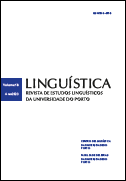The use of gender-neuter marking in Brazilian Portuguese tweets: a sociolinguist approach
Resumo
This research investigates gender-neuter marking in Brazilian Portuguese, a recent linguistic variation that has divided many opinions in Brazilian social and political circles until now. The Theory of Variation (LABOV, 2008 [1972]; WEINREICH; LABOV; HERZOG, 2006 [1968]), with a focus on Communities of Practice (ECKERT; MCCONNELL-GINET, 1992a, 1992b), supports the description and analysis conducted. To observe the variant, we opted for the social network Twitter, from which we collected 3,446 tweets produced by three subjects during the second half of 2020 who explicitly expressed a preference for the use of the neuter pronouns “Elu,” “Ilu,” “El” or “Ile.” As a selection criterion, we considered tweets containing adjectives, nouns, and pronouns whose referent was a human, and morphological markers carrying gender distinction. The predictor variables stipulated were morphosyntactic class, lexical item, the tweet topic, participant, and the reference performed by gender marks (generic or specific). The sample was submitted through the RStudio program, version 4.1.2, through which the proposed statistical treatment was carried out. The results reveal a disadvantage regarding gender-neuter marking for all participants, not showing optimistic estimates about any specific word. They also pointed out the adjective class, the affective relationship and identity topics, and the generic reference performed by gender marking as conditioners of gender-neuter employment.
Referências
Almeida, G. C. (2020). Manual para o uso da linguagem neutra em Língua Portuguesa. Research Gate. https://www.researchgate.net/publication/341736329_Manual_para_o_uso_da_linguagem_neutra_em_Lingua_Portuguesa.
Baldez, D. (2022). O uso da marcação de gênero neutro no Twitter por uma perspectiva sociolinguística. [Dissertação de Mestrado]. Pontifícia Universidade Católica do Rio Grande do Sul.
Bernini, L. (2011). Macho e fêmea Deus os criou!? A sabotagem transmodernista do sistema binário sexual. Bagoas - Estudos gays: gêneros e sexualidades, 5 (6), 15-47.
Camara Jr., J. M. (1970). Estrutura da língua portuguesa. Vozes.
Costa, J. A., & Choupina, C. M. (2012). A história e as histórias do género em português: percursos diacrónicos, sincrónicos e pedagógicos. Exedra: Revista Científica. 6, 75-86.
Eckert, P., & Mcconnell-Ginet, S. (1992a). Communities of practice: Wherelanguage, gender and power all live. In: K. Hall, M. Bucholtz, & B. Moonwomon (Eds.), Locating power: Proceedings of the second Berkeley women and language conference (pp. 89-99). Berkeley University.
Eckert, P., & Mcconnell-Ginet, S. (1992b). Think practically and look locally: Language and gender as community-based practice. Annual Review of Anthropology, 21, 461-490.
Elliott, G. (2017). Exploring Non-binary Gender Identities. [Dissertation]. De Montfort University.
Endruschat, A. (2015). Gender in Portuguese. In: M. Hellinger, & H. Motschenbacher (Eds.), Gender Across Languages (pp. 303-333). John Benjamins Publishing Company.
Freitas, M. (2015). O “x” da questão: gênero neutro como ato ético e estético?. In: P. Brito & J. Brito (Eds.), Palavras e contra palavras: cortejando a vida na estética do cotidiano (pp. 159-170). Pedro e João Editores.
Galupo, M. P., Pulice-Farrow, L., & Ramirez, J. L. (2017). Like a constantly flowing river: Gender identity flexibility among nonbinary transgender individuals. In: J. Sinnott (Ed.), Identity Flexibility During Adulthood (pp. 163-177). Springer.
Labov, W. (2008). Padrões sociolinguísticos. Parábola Editorial.
Lewaschiw, C., & Gaigaia V. (2018). Linguagem não-binária ou neutra. Identidades Fandom.https://identidades.fandom.com/pt-br/wiki/Linguagem_n%C3%A3o bin%C3%A1ria_ou_neutra
Mokwa, M. (2019). O papel e a função da linguagem não binária ou neutral no contexto dasredes online. Revista Movimento. https://movimentorevista.com.br/2019/02/o-papel-e-a-funcao-da-linguagem-nao-binaria-ou-neutral-no-contexto-das-redes-online/
Reis, N., & Pinho, R. (2016). Gêneros não-binários: Identidades, expressões e Educação. Reflexão e Ação, 24 (1), 7-25.
Santana, M. 2021. O gênero neutro: pintando o português para a luta.Diversidade e Educação, 9 (2), 695-710.
Schwindt, L. (2020a). Predizibilidade da marcação de gênero em substantivos no português brasileiro. In: D. Carvalho, & D. Brito, (Org.), Gênero e língua(gem): formas e usos (pp. 279-294). Editora da Universidade Federal da Bahia.
Schwindt, L. (2020b). Sobre gênero neutro em português brasileiro e os limites do sistema linguístico. Revista da ABRALIN, 19 (1), 1-23.
Tavits, M. & Pérez, E. (2019). Language influences mass opinion toward gender and LGBT equality. Proceedings of the National Academy of Sciences, 116 (34), 16781-16786.
Trubetzkoy, N. (1969). Principles of Phonology. University of California Press.
UBA Sociales. (2019). Lenguaje inclusivo para producciones académicas. UBA Sociales. https://www.sociales.uba.ar/2019/07/31/lenguaje-inclusivo-para-producciones-academicas/
Weinreich, U., Labov, W., & Herzog, M. (2006). Fundamentos empíricos para uma teoria da mudança linguística. Parábola.
Xie, J. (2015). Deconstructing and developing gender: the nonbinary search for identity. [Senior Honors Thesis]. Carnegie Mellon University.
Downloads
Publicado
Edição
Secção
Licença
Direitos de Autor (c) 2024 Linguística: Revista de Estudos Linguísticos da Universidade do Porto

Este trabalho encontra-se publicado com a Creative Commons Atribuição-NãoComercial 4.0.



